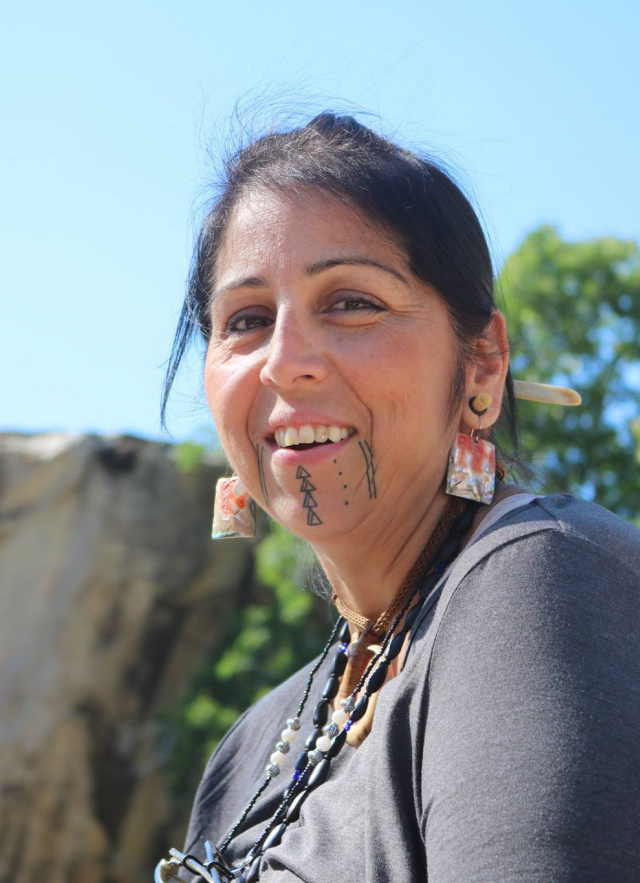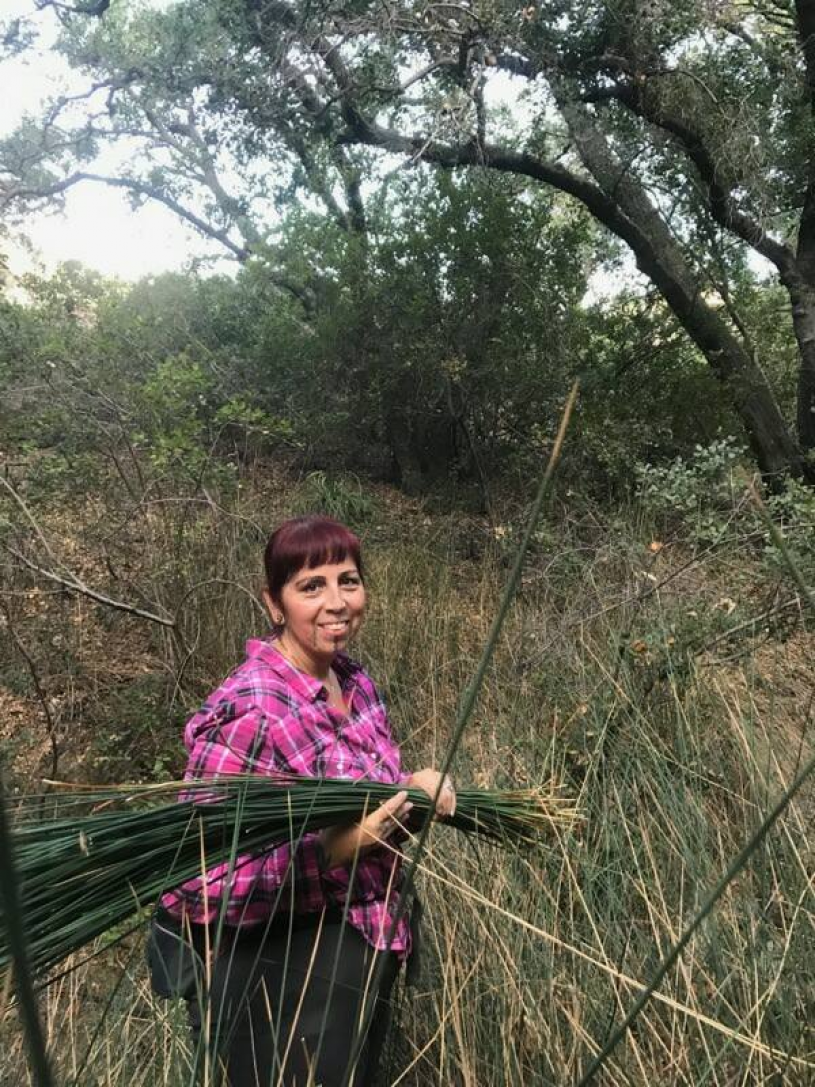Voices of L.A. Nature: An Interview with Heidi Harper Lucero
Welcome to our, "Voices of L.A. Nature," where we'll hear stories from a diverse range of Angelenos about their relationships with nature in L.A.

Welcome to our, "Voices of L.A. Nature," where we'll hear stories from a diverse range of Angelenos about their relationships with nature in L.A. This month we're celebrating Native American Heritage month, with three interviews from the community.
Heidi Harper Lucero has a deep, personal connection to L.A. nature. She was born and raised in the Long Beach area, and currently lives in Artesia. As a culture bearer, she strives to keep her cultures alive through personal practice and education. Keep reading to find out more about her relationship to acorns, mountain lions, and the rest of L.A.'s amazing nature!
On a scale of 1-10 (10 being the highest) how would your rate your love of nature today?
I would rate myself a 10.
Has this rating changed over time for you? Why/why not?
No, I've always been really involved in nature and grew up with a love of it. My parents really involved us in nature, we'd go camping, to the beach, and visit national parks a lot.
Can you tell us a little bit about your job/career?
I have two, and they are separate. My job is as a phlebotomist for Kaiser Permanente. I took the job as a way to survive, for me to have insurance and to support my son as a single parent. My career. on the other hand, is something I've been working on. Five years ago I went back to school to study Anthropology, Native American Studies, and Cultural Sustainability. Cultural sustainability is all about keeping cultures alive, not necessarily just native culture, but any cultures. For instance fishing culture, weaving culture, anything that is in fear of being lost. It is a way to document it for history and to keep it thriving.
Ultimately, my goal is to teach college two days a week and still have time for my native practices, like basket weaving and sharing my native knowledge with others. This is what is dear to my heart.
Did you grow up in Los Angeles?
I grew up in the Long Beach area. I belong to the Acjachemen tribe, which is traditionally from the Orange County area. They are sometimes referred to by the Spanish name, Juaneño, because of the mission there. I am also Ohlone, which is a tribe from the Monterrey Bay area.
Can you share a memory of where and how you played as a kid?
As a kid we didn't have a back yard, so we'd go as a family to some of the big parks close by. I remember going to El Dorado Park in Long Beach, and another one off 7th street by Wilson High School. We'd play in the park, and my dad would throw the frisbee around.
What nature places did you explore as a kid in L.A.?
The beach was the place I went to every day. We would swim and play in the sand. We would gather sand dollars. You don't see them at all on the beaches around Long Beach now. I also remember going to Griffith Park and up to the Angeles Crest Highway. We'd just go for a drive up there and get out of the city, to have some fresh air and get away from all the cars and take a hike.
How do you incorporate nature into your daily life?
Our gathering areas for basketry and food are in decline, because of urban development. So, I have started growing those plants in my yard. This way I can still be around the plants and have interactions with them everyday. I water them, I harvest from them, I tend them.
Can you tell us a bit more about the importance of gathering sites for you?
Even though I grow basketry plants in my yard, I still go out on a regular basis to gather materials. If the community at large doesn't see us gathering, and the plants do not see us out there gathering, then people are going to start viewing those spaces as useless. For instance, I went out to gather basket materials about a month and a half ago. I've been going to this same spot for the last 20 years. But this time, I was stopped by a ranger. The ranger had heard that the space was a gathering area, but had never seen anyone there gathering before. My going there helped the ranger understand the importance of the place. It helps to make sure it doesn't get developed. Also, it is where my ancestors would go to gather. That connection is important for me too.

What is your favorite nature space to visit in L.A.?
My current favorite is Redbox canyon up by Mount Wilson. It is such a peaceful place. There are lots of acorns there. Lots of culture. I feel the presence of ancestors when I am there. I usually go by myself physically, but I meet others when I am there. There is a cultural center up there too, the Haramokngna American Indian Cultural Center. I like taking the road that goes up to the tower on top of Mount Wilson. On a clear day the view is amazing!
What is your favorite plant/animal/fungus/slime mold/other organism in Los Angeles?
I have lots of favorites that are really important to me as a culture bearer. For a plant, it would be acorn. I think the acorn that is something that has sustained our people for so long. For thousands of years. Right now it is a resource that people don't know much about. It is important that people learn about the acorn. Native American cultures are often associated with corn and other domesticated agriculture, but here we ate acorns!
For an animal I would pick tukwut, which is mountain lion in my Acjachemen language. For me the mountain lion is so important because we are moving into his habitat and landscape. When we talk about development of land here, many do not acknowledge their place and that we are moving in.
Do you have a funny story about a nature experience you had in L.A.?
When my son was 8 we were visiting the Satwiwa cultural center in Northern L.A.. When we were done and walking back to the car, I saw a red tail hawk with a rabbit that it was eating. I was watching the hawk, and then my son turned to me and said, "Mom, look at that deer right there." I looked and it was NOT a deer, but a mountain lion! He wanted to take off running. I told him not to, because that is the worst thing you can do. Instead we put our arms up in the air and made ourselves look really big. It was the middle of the day, so it was pretty surprising. We got to the car safely in the end. He totally thought it was a deer!
How do you think we can make access to nature in LA more accessible for everyone? What are some of the biggest barriers?
I find the parking prices outrageous at some parks. Also, when you're in the National Forest there are only a few places to buy the parking permits, and they are in inconvenient locations and not always open. In cities they have parking apps where you can scan your license plate and pay that way. Using something like this in parks would make it easier.
As a native person, I also face barriers around getting permits so I can access the land. I am always trying to practice my cultures, but I walk in both worlds. I want to be able to practice my cultures, and be given access so I can be on the land legally. I think raising awareness around the access issues we face as native people is important. We work hard to build relationships with State Parks and National Forest staff. They give us access, but it has be renegotiated every year. This process takes a lot of time. It is hard when we are working on practices that take longer than a year to accomplish, and many government staff don't understand native philosophies. I think it will get better if we can meet and listen between the two sides. I am a bridge builder, and believe in reciprocity. There has to be work on both sides.
Lastly, land acknowledgements are becoming more and more mainstream, what do you think and feel about them?
They are important. I ALWAYS talk about and speak to the people of the land, wherever I am in the world. Whether they are alive now or have just recently become ancestors. It doesn't matter if they are physically there or not, it is for the ancestors to hear. On my own homeland, it is something that I do, so that my ancestors hear that I am there and acknowledging them.
Do you have any other questions you had wished I’d asked?
The last thing I'd like to say is how important reciprocity is. It is all about give and take. As a weaver, and a gatherer of medicine and food, I always bring a gift when I gather. Water. Seeds. A Prayer. A Song, Tobacco.
I gather for my elders, so I'm always getting extra. I make Elderberry jelly, to give to people as gifts. Elders ask me if I have any Yucca flower, or pinons. At this point, I really need a bigger freezer!
How do you want people to follow you?
Facebook: Heidi Harper Lucero + Chia Cafe Collective
Instagram: @tutu_lucero
Tumblr: @calinativeanthropologist